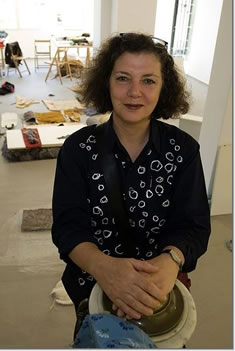The Princeton University Art Museum presents Princeton and the Gothic Revival. 1870–1930, an exhibition on view February 25–June 24, 2012.
 Cram and Ferguson, architects, Boston, fl. 1915-1941: Proposed exterior of chapel (S41). Watercolor on wove paper, approximately 96.5 x 71.1 cm. University Archives, Department of Rare Books and Special Collections, Princeton University Library. Image Courtesy the University Archives, Department of Rare Books and Special Collections, Princeton University Library
Cram and Ferguson, architects, Boston, fl. 1915-1941: Proposed exterior of chapel (S41). Watercolor on wove paper, approximately 96.5 x 71.1 cm. University Archives, Department of Rare Books and Special Collections, Princeton University Library. Image Courtesy the University Archives, Department of Rare Books and Special Collections, Princeton University Library
This exhibition of forty works explores America’s changing attitudes toward the art and architecture of the Middle Ages around the turn of the twentieth century. Organized by Dr. Johanna G. Seasonwein, the Museum’s Andrew W. Mellon Curatorial Fellow for Academic Programs, Princeton and the Gothic Revival investigates, the adoption of the Gothic Revival as a style appropriate for American universities, as seen through the lens of Princeton University’s campus and collections.
Princeton and the Gothic Revival covers the years between the dedication of the first High Victorian Gothic building on the Princeton campus, Chancellor Green Library, and the completion of the extraordinary University Chapel. The exhibition draws from the Art Museum’s collections and resources of Princeton’s Firestone Library and the University Archives, along with those of the Metropolitan Museum of Art and other institutions, to highlight Princeton University’s role as a major patron of Gothic Revival art and architecture and the role of this style— of England’s “ancient universities”—in shaping the identity of modern-day Princeton.
“Princeton’s campus and collections provide a unique opportunity to explore the transformation of the Gothic Revival into a symbol of the American academy. Princeton moved forward into the twentieth century by essentially looking back—at the architectural style of Oxford and Cambridge,” says Dr. Seasonwein, a historian of the art of the Middle Ages. “Ultimately, Princeton and the Gothic Revival examines how the language of medieval forms was used to articulate a new model of American higher education, both in campus design and in the classroom.”
Princeton and the Gothic Revival: 1870–1930 is organized into four sections:
The Gothic Revival prior to 1870 introduces the Gothic Revival movement in America and its English roots. Wealthy Americans visiting medieval sites or modern “Gothick” estates such as Fonthill Abbey often were inspired to design their own Gothic Revival homes that were a mix of the authentic and the fantastic. This section features a design for a stained-glass window for Fonthill Abbey by painter Benjamin West and a design for the first American Gothic Revival estate by noted architect Alexander Jackson Davis (on loan from the Metropolitan Museum of Art).
The Gothic Revival in the Gilded Age presents the first High Victorian Gothic buildings constructed on the Princeton campus with a mix of medieval and other styles that reflected the donors’ interest in the Aesthetic movement, and its eclectic approach to design. This section highlights the former Marquand Chapel, designed by renowned architect Richard Morris Hunt. The chapel was later lost to fire. Featured works include Hunt’s original architectural plans and artist Francis Lathrop’s models for one of the stained-glass windows.
The Middle Ages and the Modern University investigates the connection between architectural style and academic identity and use. This section presents works relating to the first Biological Laboratory and Art Museum buildings, both of which were constructed in the Romanesque Revival style. Also on view are some of the earliest works of medieval art purchased by the Museum (one of the great repositories for medieval art in the United States), including one of the first English medieval alabaster reliefs to enter an American collection.
The Collegiate Gothic Campus explores the development of Princeton’s campus in the late 19th and early 20th centuries. The new buildings, which simulated those of Oxford and Cambridge, conferred an instant pedigree on the University and communicated the school’s desired stature to the student body (at that time all male and almost exclusively white and Christian). This section includes images related to many of the Gothic Revival buildings on campus, most notably a set of never-before exhibited watercolors of the original designs for the University Chapel.
“Princeton and the Gothic Revival continues the Museum’s interest in understanding the ways in which Princeton University’s buildings and its design choices have shaped its identity as one of the world’s great research universities and vice versa, while offering a lens through which we can reconsider one of the nineteenth century’s most significant design movements.” said James Steward, director of the Princeton University Art Museum.
In conjunction with Princeton and the Gothic Revival, a mobile web application will take the exhibition out of the Museum and onto the campus for visitors. The tour will provide a rich multimedia exploration of nine campus buildings that are featured in the exhibition and related catalogue. Drawing from the special collections of the Firestone Library and Archives and the Museum Collections, the experience will emphasize existing and historic sites presented in the exhibition, highlighting the recently digitized Historical Photograph Collection, Grounds and Buildings Series from the University Archives, as well as historic photographs and audio that features experts from across the campus.
Princeton University Art Museum Princeton, NJ 08544 609-258-3788
www.artmuseum.princeton.edu



